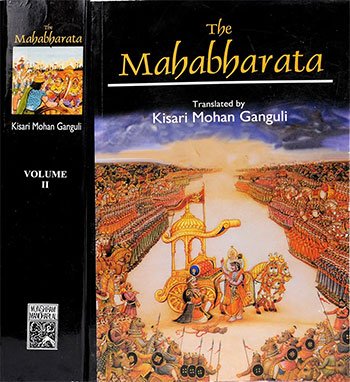Section VIII - Varshas and Mountains of Romanaka and Hiranmaya
Book index: Mahabharata (English)
This page contains a summary of the Mahabharata Section VIII including examples of moral lessons in daily life. The Maha-Bharata is one of the largest epics ever written containing roughly 100,000 Sanskrit verses. It deals with the legendary history of ancient India and contains a large number of interwoven tales.
Short summary of the chapter:
In this passage, King Dhritarashtra asks Sanjaya to tell him about the various Varshas and mountains along with the beings that reside there. Sanjaya goes on to describe Romanaka and Hiranmaya Varshas, highlighting the characteristics and longevity of the people living there. He also mentions the Sringavat mountain with its three beautiful summits, each adorned with jewels and palatial mansions. Sanjaya further describes the Varsha of Airavat, where the sun's heat is absent, and the inhabitants possess lotus-like qualities and have control over their senses, living for thirteen thousand years.
Sanjaya then speaks of Lord Hari residing on a golden chariot with magical creatures and unparalleled power, symbolizing the creator and destroyer of the universe. He emphasizes that Lord Hari is present in all elements of nature and is the source of all prosperity. Dhritarashtra, upon hearing this, reflects on the transient nature of life and the omnipotence of Time, ultimately acknowledging Nara and Narayana as the ultimate destroyers and creators.
The passage conveys the cyclical nature of life, where Time plays a crucial role in the destruction and creation of the universe. It emphasizes the impermanence of existence and the omnipotence of divine beings like Nara and Narayana. Dhritarashtra's contemplation on the transient nature of life and the power of Time showcases his philosophical depth and understanding of the cosmic order. The description of the different Varshas and mountains, along with the mention of Lord Hari, adds a mystical and spiritual dimension to the narrative, alluding to the larger cosmic principles at play in the universe.
Full English translation:
This page is merely a summary which is automatically generated. If you are looking for authentic sources such as the Sanskrit text or the Full English translation of Mahabharata Section VIII - Varshas and Mountains of Romanaka and Hiranmaya, have a look at the following articles:
Section VIII, online text
English translation by Kisari Mohan Ganguli.
Read this and other chapters online.
Mahabharata (English Summary)
by Kisari Mohan Ganguli | ISBN-10: 8121505933
Buy the latest edition:
FAQ of Mahabharata, Section VIII:
What are the characteristics of the Varshas and mountains mentioned in the story?
The Varshas are inhabited by people of different complexions, strengths, and lifespans. The mountains are adorned with jewels, mansions, and divine beings like Garuda.
Who is Lord Hari and what significance does he hold in the story?
Lord Hari, residing in a gold chariot, is the all-powerful creator and destroyer of the universe. He is identified as Nara and Narayana, embodying time and omniscience.
Daily life: Varshas and Mountains of Romanaka and Hiranmaya:
In this story from the Mahabharata, Sanjaya describes various fantastical realms to King Dhritarashtra, each with its own unique characteristics and inhabitants living extraordinarily long and joyful lives. It paints a picture of a world far different from our own, filled with divine beings, magical mountains, and celestial phenomena. The description transitions into the omnipresence of Lord Hari (Vishnu), emphasizing his power and role in the creation, sustenance, and destruction of the universe.
To apply this narrative to daily life, one can focus on the underlying messages of universal interconnectedness, the transient nature of existence, and the importance of recognizing a higher power or the forces of nature that guide the course of life. It reminds us to appreciate the beauty in the world, acknowledge the diversity of life and experiences beyond our immediate understanding, and maintain faith in the cyclical patterns of life and death. By embracing these concepts, individuals can live with a sense of harmony, purpose, and acceptance of the natural order of things.
